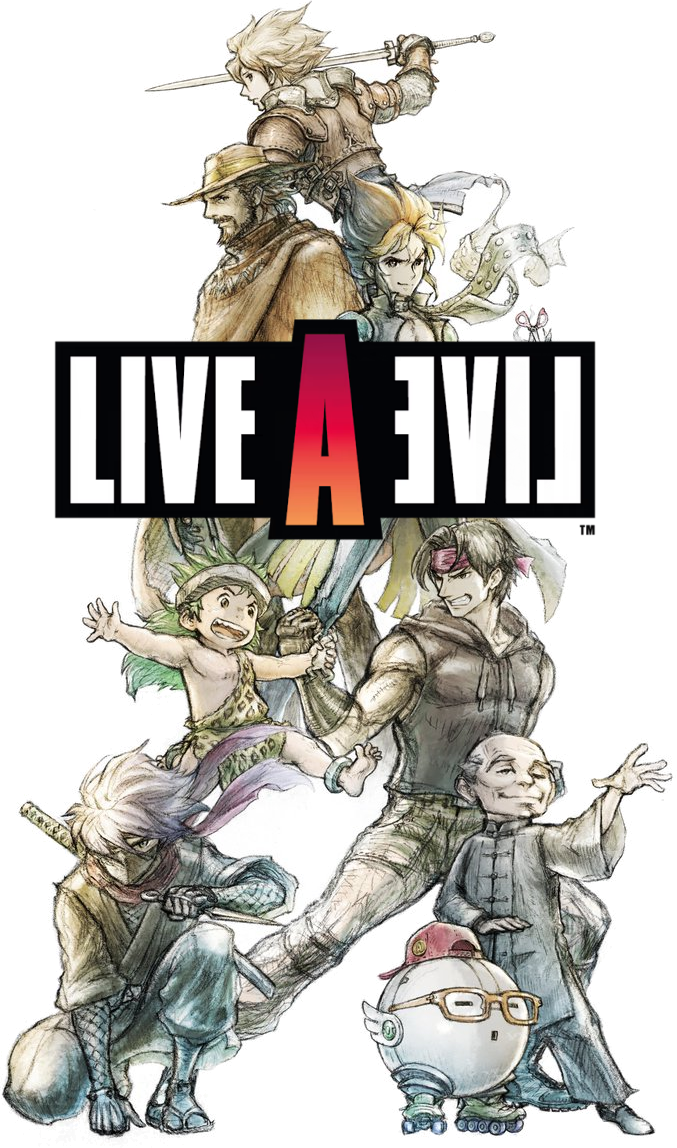
Live A Live (stylized as LIVE A ƎVI⅃) is an Anthology Role-Playing Game by Squaresoft, originally released on the Super Famicom in 1994. It was the directorial debut of Takashi Tokita, who would later go on to direct other Square classics such as Chrono Trigger and Parasite Eve, as well as the first Square title where Yoko Shimomura served as the composer.
The game features seven storylines set in multiple time periods, with each taking place in their own settings and genres. While the individual chapters are seemingly standalone at first, they eventually tie together. The storylines each draw influence from different sources, as wide and varied as '80s anime, spaghetti Westerns, fighting games, 2001: A Space Odyssey, and Alien, to name but a few. They are, in chronological order:
- "The First"
 : In a prehistoric era pre-dating spoken language, a young caveman known as Pogo finds himself trying to save a young woman from being sacrificed.
: In a prehistoric era pre-dating spoken language, a young caveman known as Pogo finds himself trying to save a young woman from being sacrificed. - "The Successor"
 : In Imperial China, the elderly shifu of the Earthen Heart school searches for a successor to carry on his teachings, taking under his wing a bandit, a thief, and a cutpurse.
: In Imperial China, the elderly shifu of the Earthen Heart school searches for a successor to carry on his teachings, taking under his wing a bandit, a thief, and a cutpurse. - "The Infiltrator"
 : In the twilight of Edo Japan, a novice ninja named Oboromaru is tasked with infiltrating a castle fortress to rescue a political prisoner.
: In the twilight of Edo Japan, a novice ninja named Oboromaru is tasked with infiltrating a castle fortress to rescue a political prisoner. - "The Wanderer"
 : In the Wild West, a wandering outlaw known as the Sundown Kid is roped into saving a village under siege from bandits.
: In the Wild West, a wandering outlaw known as the Sundown Kid is roped into saving a village under siege from bandits. - "The Strongest"
 : In the present day, a professional street fighter named Masaru Takahara takes on the fighting masters of the world to test his mettle.
: In the present day, a professional street fighter named Masaru Takahara takes on the fighting masters of the world to test his mettle. - "The Outsider"
 : In the near future, an orphaned youth named Akira must master his latent psychic powers to save the world from a dangerous conspiracy.
: In the near future, an orphaned youth named Akira must master his latent psychic powers to save the world from a dangerous conspiracy. - "The Mechanical Heart"
 : In the distant future, a robot called "Cube" must help the crew of a starship in deep space survive a perilous journey back to Earth.
: In the distant future, a robot called "Cube" must help the crew of a starship in deep space survive a perilous journey back to Earth.
Completing all the above chapters unlocks the final eighth chapter:
- "The Lord of Dark"
 : In the Middle Ages, a brave knight named Oersted is tasked with rescuing a princess from an evil lord.
: In the Middle Ages, a brave knight named Oersted is tasked with rescuing a princess from an evil lord.
After that, the player decides which path to take...
Live A Live deviates from the usual Squaresoft fare when it comes to the battle system. While combat is still turn-based like your standard RPG, it takes place on a 7x7 grid with some movement elements you'd expect from a Strategy RPG; characters need to take their position into account when making attacks, Geo Effects can alter parts of the battlefield, and some moves require charging and prevent said characters from moving. Although the battle system stays the same throughout the game, its prevalence varies since each chapter has its own distinct atmosphere, focus, and art style. For example, the Twilight of Edo Japan chapter revolves around a Stealth-Based Mission, the Present Day chapter takes inspiration from Fighting Games and features combat exclusively, the Distant Future chapter has Survival Horror undertones with very little combat, etc.
Live A Live was never officially released outside Japan due to poor sales, and seemed to be trapped there... until 2022, when a remake in the "HD-2D" style of Octopath Traveler and Triangle Strategy was released for the Nintendo Switch on July 22, 2022, which also features voice acting in both languages. Tokita returns as a major creative supervisor with Shimomura supervising the rearrangement of the soundtrack, even personally rearranging several tracks.
Compare Bahamut Lagoon and Treasure of the Rudra, two other RPGs from the same time period by Square that also stayed in Japan. Also compare Final Fantasy IV: The After Years, Kingdom Hearts: Birth by Sleep, and Octopath Traveler, three later Square games with a similar storytelling format.
A demo of the remake was released for the Nintendo Switch's eShop, featuring truncated versions of the Imperial China, Twilight of Edo Japan and Distant Future chapters, which you can import your progress from any of them into the full game past the demo's cutoff point.
The remake was ported to PlayStation 4, PlayStation 5, and Steam on April 27, 2023, with the same demo system in place but with the Imperial China chapter being replaced with the Wild West.
Not to be confused with the Haruhi Suzumiya story "Live Alive", Alive A Life, Date A Live, nor is it the opposite of Kill la Kill.
Beware of unmarked spoilers! You Have Been Warned.
